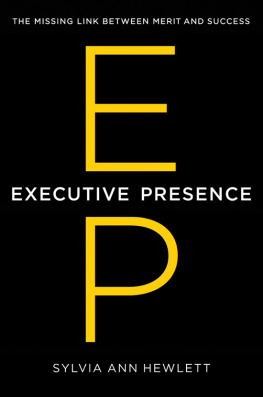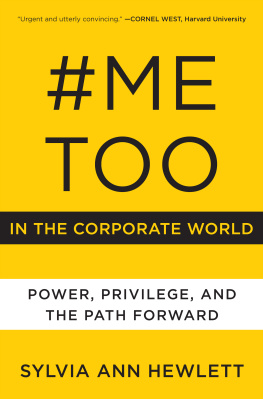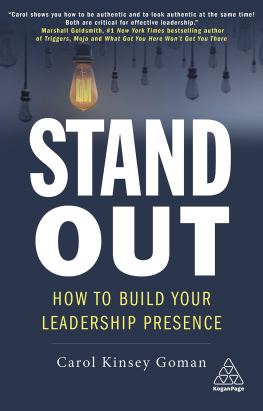To the band of heroes who made this research possible:
Barbara Adachi, Antoine Andrews, Cynthia Bowman, Daina Chiu, Jennifer Christie, Deborah Elam, Anne Erni, Gail Fierstein, Anne Fulenwider, Michelle Gadsden-Williams, Trevor Gandy, Heide Gardner, Rosalind Hudnell, Fran Laserson, Janice Little, Carolyn Buck Luce, Tom Morrison, Nisha Rao, Eileen Taylor, Geri Thomas, Karyn Twaronite, Anr Williams, Melinda Wolfe, and Tony Wright.
CONTENTS
This book is close to my heart, and it gives me particular pleasure to acknowledge the extensive help Ive received from family and colleagues.
First and foremost Id like to thank my husband, Richard Weinert, and our children, Shira, Lisa, David, Adam, and Emma. Their enthusiasm and support has lightened my load during the months Ive spent focused on this book. Im immensely appreciative.
I owe a huge debt of gratitude to Melinda Marshall. Her deep knowledge of this subject matter and stellar writing skills contributed enormously to this book. I am extremely grateful to her.
My senior teamPeggy Shiller, Lauren Leader-Chive, Laura Sherbin, Tai Green, and Karen Sumberghas also been extraordinary. In particular, Peggys management prowess and Lauras quantitative skills were critical in helping me meet the ambitious deadlines of this fast-track book. I thank them both.
Im also enormously grateful to the senior executives (and their companies) who underwrote and helped shape the survey research that underpins this book: Jennifer Christie and Anr Williams (American Express), Cynthia Bowman and Geri Thomas (Bank of America), Anne Erni and Melinda Wolfe (Bloomberg), Trevor Gandy (Chubb), Michelle Gadsden-Williams (Crdit Suisse), Barbara Adachi and Tom Morrison (Deloitte), Nisha Rao and Eileen Taylor (Deutsche Bank), Karyn Twaronite (EY), Antoine Andrews (Gap Inc.), Deborah Elam (GE), Gail Fierstein (Goldman Sachs), Rosalind Hudnell (Intel), Heide Gardner and Tony Wright (Interpublic Group and Lowe and Partners), Anne Fulenwider ( Marie Claire ), Daina Chiu and Janice Little (McKesson), Fran Laserson (Moodys Foundation). Their generous support has gone well beyond funding. Over the past two years these corporate leaders provided precious access and lent wise counsel. A big thank-you.
The co-chairs of the Task Force for Talent Innovation contributed key insights and thought leadership. I would like to thank Caroline Carr, Anthony Carter, Erika DEgidio, Valerie Grillo, Patricia Fili-Krushel, Cassandra Frangos, Sandy Hoffman, Annalisa Jenkins, Patricia Langer, Leena Nair, Lisa Garcia Quiroz, Craig Robinson, Lucy Sorrentini, and Elana Weinsteinfor their belief in the importance of this study, and their ongoing dedication to the mission of our organization.
A special word of appreciation to Jonathan Burnham and Hollis Heimbouch of HarperCollins. Their commitment to this project was critical to getting the book off the ground. Im also indebted to Molly Friedrich, who encouraged me to transform dense research into much more narrative-driven prose. Her advice was spot on. In addition, I want to thank my daughter Lisa Weinert and Fiona McMorrough for their contributions to the communication strategy that underpins this book.
A word of thanks to DeAnne Aguirre, DArmy Bailey, James Charrington, Suzi Digby, Brady Dougan, Bob Dudley, Kent Gardiner, Judith Harrison, Mellody Hobson, Linda Huber, Sallie Krawcheck, Laura Lopata, Carolyn Buck Luce, Debbie Maples, Tim Melville-Ross, Harold Morrison, Kerrie Peraino, Katherine Phillips, Trevor Phillips, Ripa Rashid, Jane Shaw, Keisha Smith, Debora Spar, Mark Stephanz, Joe Stringer, Joel Tealer, Tiger Tyagarajan, Richard Weinert, and Cornel Westand to all the women and men who took part in focus groups, interviews, and Insights In-Depth sessions.
Im deeply appreciative of the research support and editorial talents of the CTI team: Michael Abrams, Noni Allwood, Joseph Cervone, Terri Chung, Fabiola Dieudonn, Colin Elliott, Courtney Emerson, Christina Fargnoli, Mark Fernandez, Catherine Fredman, Tara Gonsalves, Lawrence Jones, Anne Mathews, Andrea Turner Moffitt, Birgit Neu, Nicholas Sanders, Sandra Scharf, Roopa Unnikrishan, and Jennifer Zephirin. I also want to thank Bill McCready, Stefan Subias, and the team at Knowledge Networks, who fielded the survey and were an invaluable resource throughout the course of the data collection.
Last but not least, a heartfelt thank-you to the members of the Task Force for Talent Innovation for providing cutting-edge ideas and impressive amounts of collaborative energy: Elaine Aarons, Rohini Anand, Redia Anderson, Renee Anderson, Diane Ashley, Nadine Augusta, Terri Austin, Ann Beynon, Anne Bodnar, Kristen Bruner, Kenneth Charles, Tanya Clemons, Joel Cohen, Nicola Davidson, Whitney Delich, Jill DeSimone, Nancy Di Dia, Mike Dunford, Vanessa Edwards, Lance Emery, Traci Entel, Nicole Erb, Titus Erker, Grace Figueredo, Trevor Gandy, Lisa George, Tina Gilbert, Tim Goodell, Kathy Hannan, Kara Helander, Ginger Hildebrand, Alex Hiller, Kate Hoepfner-Karle, Celia Pohani Huber, Sharon Jacobs, Nia Joynson-Romanzina, Eman Khalifa, Inci Korkmaz, Kelly Knight, Denice Kronau, Janina Kugel, Yolanda Londono, Margaret Luciano-Williams, Lori Massad, Donna-Marie Maxfield, Ana Duarte McCarthy, Beth McCormick, Mark McLane, Piyush Mehta, Sylvester Mendoza, Carmen Middleton, Erica Nemser, Pamela Norley, Mark Palmer-Edgecumbe, Pamela Paul, Sherryann Plesse, Monica Poindexter, Susan Reid, Jennifer Rickard, Karin Risi, Eiry Roberts, Dwight Robinson, Jacqueline Rolf, Jennifer Silva, Debbie Storey, Lynn Utter, Cassy Van Dyke, Vera Vitels, Lynn OConnor Vos, Jo Weiss, Meryl Zausner, and Fatemeh Ziai.
My first run-in with executive presence (EP) occurred when I was seventeen. I was in the second year of the sixth form and applying for the ultimate reach schoolsOxford and Cambridge. Id gotten a certain distance, having passed the rigorous entrance examinations, but was now facing a round of interviews. I anticipated a rough time. I knew enough about the world to understand that I came from the wrong background (Welsh, working-class), and my knees knocked and I broke out in a cold sweat at the mere thought of facing the scrutiny of Oxbridge dons. I feared they would size me up and decide I did not have it, which of course they had in spades.
Seeing my distress and eager to be helpful, my mum volunteered to dress me for my first interview at St. Annes College, Oxford. Shed read a ton of Nancy Mitford novels and thought she knew what kind of clothes the upper crust wore. I didnt push backI knew I was clueless. Id grown up in a backwater mining community and had few clothes and no social graces. I was eager for help. Having battled huge odds to pass the entrance tests, I knew that only this interview stood between me and a coveted place at one of the most distinguished universities in Europe. And I had a good shothalf of those interviewed got a place. I just had to figure out how to look the part of someone who moved in the right circles.
So early one December morning we hit the winter clearance salesrising at the crack of dawn so that we would be at the head of the herd storming C&A (a department store in Cardiff). And did we score! In the sales racks of the ladies suits department my mum found exactly what she was looking for: a nubby tweed suit with a fox collar. And I dont mean the collar was made out of fox fur. I mean the collar was a foxor most of a fox. The tail was a big feature (you were supposed to fling it around your neck as extra protection against the winter cold), and there were beady eyes and two sets of claws.
As might be expected, my Oxford interview was a disaster. The admissions committee was gobsmacked. I literally took their breath away. They simply did not know what to make of a seventeen-year-old who wore a fox and seemed to be trying to look like the Queen Motherespecially since this particular seventeen-year-old spoke English with a thick working-class Welsh accent (more on that in chapter 3). I did not get in... and was devastated. But it was hard to blame my mum, she had tried so hard.






